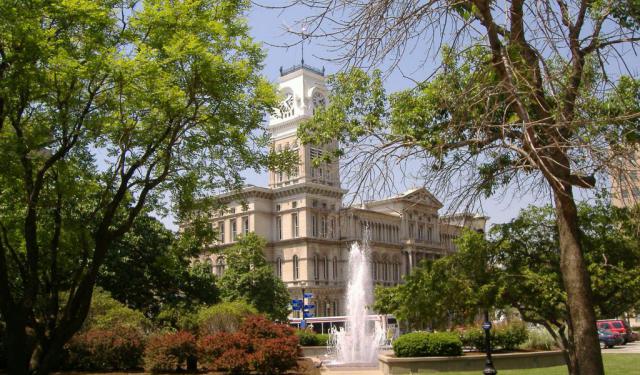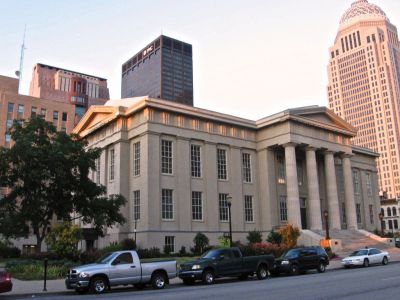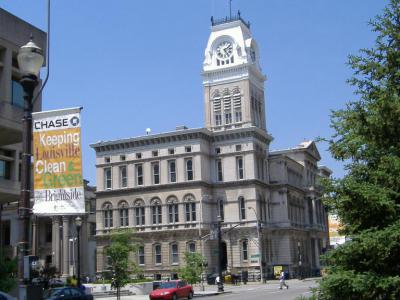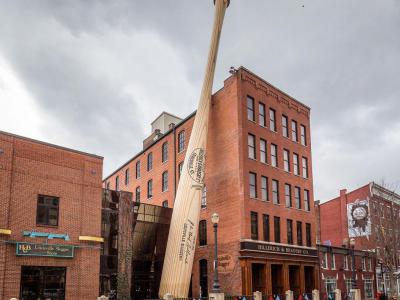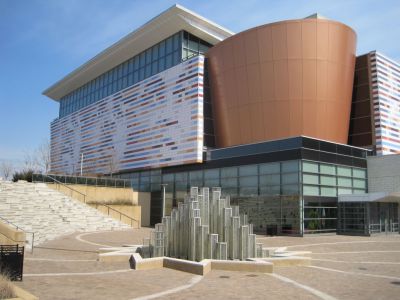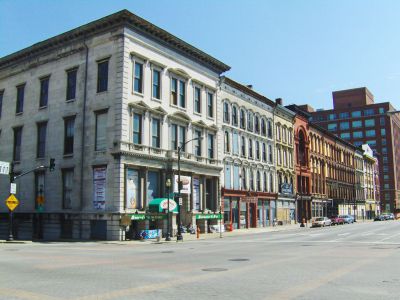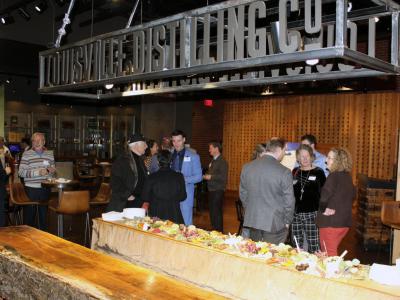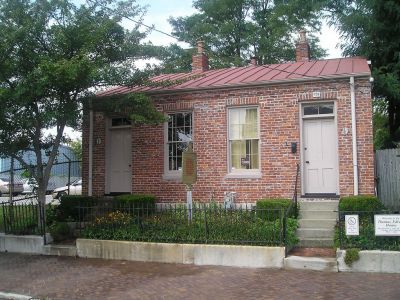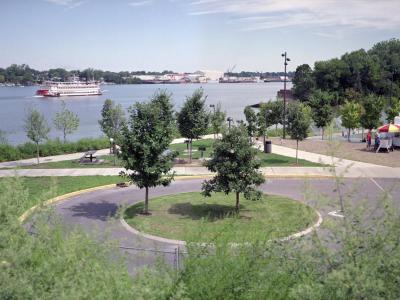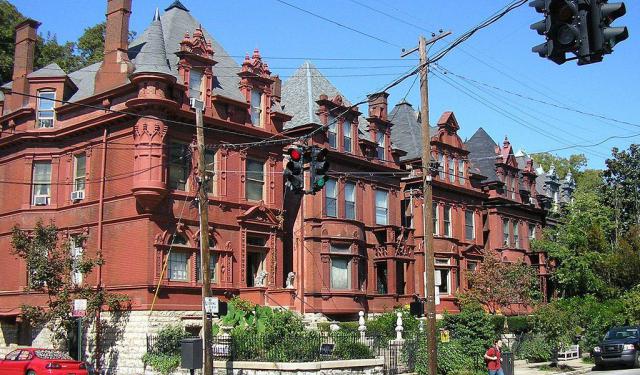Louisville Introduction Walking Tour (Self Guided), Louisville
Poised on the banks of the Ohio River, Kentucky's largest city Louisville blends small-town charm with urban sophistication. The first European settlement in the vicinity of modern-day Louisville was on Corn Island, established in 1778 by Col. George Rogers Clark, credited as the founder of the city. Two years later, the Virginia General Assembly approved the town charter of Louisville. The city was named in honor of King Louis XVI of France, whose soldiers were then aiding Americans in the Revolutionary War.
Early Louisville was a major shipping port with slaves working in a variety of associated trades. The city was often a point of escape for slaves to the north. During the Civil War, Louisville was a major stronghold of Union forces, which kept Kentucky firmly in the Union.
In 1914, the City of Louisville passed a racially-based zoning residential zoning code, following Baltimore, Atlanta, and a handful of cities in the Carolinas. In 1929, it completed the lock and dam in the Falls of the Ohio and began referring to itself as "where Northern enterprise and Southern hospitality meet". Between the industrial boom of that year and through the Great Depression, Louisville gained 15,000 new residents, about three percent of them black.
Since the 1980s, many of the city's urban neighborhoods have been revitalized into areas popular with young professionals and college students. As of the late 1990s, Downtown has experienced significant residential, tourist and retail growth, including the addition of major sports complexes such as Louisville Slugger Field, conversion of waterfront industrial sites into Waterfront Park (an 85-acre outdoor space along the Ohio River), and openings of varied museums.
Science and architecture buffs will certainly take interest in the Thomas Edison House and the Old Bank of Louisville building, while those big on sports should consider visiting Louisville Slugger Museum & Factory (showcasing how the famous baseball bats are made), and the Muhammad Ali Center (celebrating the life of Louisville-born, world-famous boxer Muhammad Ali). And if you're keen on whiskey, you might as well be willing to check out Whiskey Row – apart from being the home to KFC, Louisville is known for bourbon that is long associated with Kentucky.
To acquaint yourself with these and other delights of Louisville, a treasure trove of themed attractions, take this self-guided introduction walk.
Early Louisville was a major shipping port with slaves working in a variety of associated trades. The city was often a point of escape for slaves to the north. During the Civil War, Louisville was a major stronghold of Union forces, which kept Kentucky firmly in the Union.
In 1914, the City of Louisville passed a racially-based zoning residential zoning code, following Baltimore, Atlanta, and a handful of cities in the Carolinas. In 1929, it completed the lock and dam in the Falls of the Ohio and began referring to itself as "where Northern enterprise and Southern hospitality meet". Between the industrial boom of that year and through the Great Depression, Louisville gained 15,000 new residents, about three percent of them black.
Since the 1980s, many of the city's urban neighborhoods have been revitalized into areas popular with young professionals and college students. As of the late 1990s, Downtown has experienced significant residential, tourist and retail growth, including the addition of major sports complexes such as Louisville Slugger Field, conversion of waterfront industrial sites into Waterfront Park (an 85-acre outdoor space along the Ohio River), and openings of varied museums.
Science and architecture buffs will certainly take interest in the Thomas Edison House and the Old Bank of Louisville building, while those big on sports should consider visiting Louisville Slugger Museum & Factory (showcasing how the famous baseball bats are made), and the Muhammad Ali Center (celebrating the life of Louisville-born, world-famous boxer Muhammad Ali). And if you're keen on whiskey, you might as well be willing to check out Whiskey Row – apart from being the home to KFC, Louisville is known for bourbon that is long associated with Kentucky.
To acquaint yourself with these and other delights of Louisville, a treasure trove of themed attractions, take this self-guided introduction walk.
How it works: Download the app "GPSmyCity: Walks in 1K+ Cities" from Apple App Store or Google Play Store to your mobile phone or tablet. The app turns your mobile device into a personal tour guide and its built-in GPS navigation functions guide you from one tour stop to next. The app works offline, so no data plan is needed when traveling abroad.
Louisville Introduction Walking Tour Map
Guide Name: Louisville Introduction Walking Tour
Guide Location: USA » Louisville (See other walking tours in Louisville)
Guide Type: Self-guided Walking Tour (Sightseeing)
# of Attractions: 9
Tour Duration: 2 Hour(s)
Travel Distance: 4.5 Km or 2.8 Miles
Author: Cathy
Sight(s) Featured in This Guide:
Guide Location: USA » Louisville (See other walking tours in Louisville)
Guide Type: Self-guided Walking Tour (Sightseeing)
# of Attractions: 9
Tour Duration: 2 Hour(s)
Travel Distance: 4.5 Km or 2.8 Miles
Author: Cathy
Sight(s) Featured in This Guide:
- Metro Hall
- City Hall
- Louisville Slugger Museum and Factory
- Muhammad Ali Center
- Old Bank of Louisville
- Whiskey Row
- Angel's Envy Distillery
- Thomas Edison House
- Waterfront Park
1) Metro Hall
Louisville Metro Hall, originally known as the Jefferson County Courthouse, is the historic seat of government in downtown Louisville. Construction began in 1836, and by 1842, the unfinished structure was already in use by both city and county authorities. Designed by architect Gideon Shryock in the Greek Revival style, the building was initially conceived with grand elements such as a full Doric portico, a cupola, and symmetrical wing porticos. However, after Shryock's resignation in 1842, the project was scaled down under engineer Albert Fink, and it was not completed until 1860. Despite public criticism at the time, the structure went on to play key roles in city, state, and national history.
In the 1840s, the courthouse grounds witnessed both slave auctions and abolitionist speeches, reflecting Kentucky’s conflicted identity before the Civil War. During the war, it briefly served as the state capitol when Frankfort was occupied by Confederate forces. Hopes that the building would become Kentucky’s permanent capitol were dashed, earning it the nickname “Guthrie’s folly,” after politician James Guthrie. A 1905 fire prompted renovations by Brinton B. Davis, and by the mid-20th century, preservation efforts began to outweigh calls for demolition.
Listed on the National Register of Historic Places in 1972, the building is now known as Louisville Metro Hall and houses the Mayor’s Office and several judicial and administrative offices. Its grounds feature two significant statues: one of Thomas Jefferson and another of King Louis XVI, the latter gifted by Montpellier, France. The latter statue was damaged during the 2020 protests, symbolizing the evolving public dialogue around civic monuments.
In the 1840s, the courthouse grounds witnessed both slave auctions and abolitionist speeches, reflecting Kentucky’s conflicted identity before the Civil War. During the war, it briefly served as the state capitol when Frankfort was occupied by Confederate forces. Hopes that the building would become Kentucky’s permanent capitol were dashed, earning it the nickname “Guthrie’s folly,” after politician James Guthrie. A 1905 fire prompted renovations by Brinton B. Davis, and by the mid-20th century, preservation efforts began to outweigh calls for demolition.
Listed on the National Register of Historic Places in 1972, the building is now known as Louisville Metro Hall and houses the Mayor’s Office and several judicial and administrative offices. Its grounds feature two significant statues: one of Thomas Jefferson and another of King Louis XVI, the latter gifted by Montpellier, France. The latter statue was damaged during the 2020 protests, symbolizing the evolving public dialogue around civic monuments.
2) City Hall
Louisville City Hall, constructed between 1870 and 1873, stands as one of the city’s most prominent civic landmarks. Originally built to serve as the headquarters of Louisville’s municipal government, it has since transitioned to house the offices and chambers of the Louisville Metro Council following the merger with Jefferson County. Throughout its long history, the building has remained a central symbol of local governance and civic pride.
The architecture of City Hall reflects a confident and ambitious post-Civil War Louisville, combining Italianate and Second Empire styles with elements of Beaux Arts and Romanesque Revival. A notable detail above the main entrance is the pediment relief featuring the city seal and a steam engine moving past southern foliage-emblazoned with the word “Progress” and dated 1871. Additional carvings above side windows depict livestock heads, a nod to the city’s agricultural roots.
City Hall rises three stories above a raised basement and retains much of its original exterior form. Inside, however, it has undergone extensive restoration efforts over the years. A Greco-Roman style annex was added in 1909, designed by Cornelius Curtin. The structure’s most iconic element is its 195-foot clock tower with a mansard roof, completed in 1876 after the original burned down. The tower’s three-ton bell rang until the 1960s, with several repairs attempted before it was fully restored in 1991.
Recognized for its historical and architectural significance, Louisville City Hall was added to the National Register of Historic Places in 1976. Today, it remains a distinguished fixture in downtown Louisville, reflecting both the city’s 19th-century aspirations and its continued civic role.
The architecture of City Hall reflects a confident and ambitious post-Civil War Louisville, combining Italianate and Second Empire styles with elements of Beaux Arts and Romanesque Revival. A notable detail above the main entrance is the pediment relief featuring the city seal and a steam engine moving past southern foliage-emblazoned with the word “Progress” and dated 1871. Additional carvings above side windows depict livestock heads, a nod to the city’s agricultural roots.
City Hall rises three stories above a raised basement and retains much of its original exterior form. Inside, however, it has undergone extensive restoration efforts over the years. A Greco-Roman style annex was added in 1909, designed by Cornelius Curtin. The structure’s most iconic element is its 195-foot clock tower with a mansard roof, completed in 1876 after the original burned down. The tower’s three-ton bell rang until the 1960s, with several repairs attempted before it was fully restored in 1991.
Recognized for its historical and architectural significance, Louisville City Hall was added to the National Register of Historic Places in 1976. Today, it remains a distinguished fixture in downtown Louisville, reflecting both the city’s 19th-century aspirations and its continued civic role.
3) Louisville Slugger Museum and Factory (must see)
The Louisville Slugger Museum & Factory, located in Louisville’s West Main District, is a celebrated destination that explores the legacy of America's most iconic baseball bat. Situated on Museum Row, the museum shares the rich history of the Louisville Slugger brand-from its roots in the 1880s to its place in today’s pop culture. The story began in 1884 when young Bud Hillerich crafted a bat for Pete Browning, a local star whose impressive performance with it helped spark the legend. Over the years, the production site relocated to various locations before returning to Louisville in 1996, when the museum and factory officially opened at 8th and Main Streets.
Visitors can tour the working factory floor, where bats are still made for professional players, and witness the full process-from raw timber to the finished product. The experience begins with a film that transports guests to the forests where the story unfolds. Along the way, interactive displays allow visitors to handle game-used bats, face a 90-mph fastball simulation, and swing replica bats used by legends like Babe Ruth. The museum even lets guests order personalized bats, complete with custom engravings.
A popular feature is the towering 120-foot bat that leans against the building-a Louisville landmark. Families can enjoy exhibits like the limestone baseball glove sculpture and a hands-on batting cage. Each guest receives a free mini-bat at the end of the tour. The museum also hosts pop culture exhibits in collaboration with partners like the Charles M. Schulz Museum and LEGO artists and brings the experience to stadiums nationwide through its Mobile Museum.
Owned by the Hillerich family and operated in partnership with Wilson Sporting Goods, the museum blends nostalgia, craftsmanship, and baseball history into a uniquely American experience that continues to evolve with the sport.
Why You Should Visit:
To experience first-hand history-in-the-making strolling through the actual factory where world-famous Louisville Slugger bats are created.
Tip:
In addition to a free miniature souvenir bat at the end of the tour, you can even create a bat with your own name on it, just like the pros.
They make great gifts for all kinds of special occasions, from newborn babies to groomsmen gifts to team trophies and more. The museum store is also loaded with lots of sporty merchandise for every budget. So, be sure to swing by!
Visitors can tour the working factory floor, where bats are still made for professional players, and witness the full process-from raw timber to the finished product. The experience begins with a film that transports guests to the forests where the story unfolds. Along the way, interactive displays allow visitors to handle game-used bats, face a 90-mph fastball simulation, and swing replica bats used by legends like Babe Ruth. The museum even lets guests order personalized bats, complete with custom engravings.
A popular feature is the towering 120-foot bat that leans against the building-a Louisville landmark. Families can enjoy exhibits like the limestone baseball glove sculpture and a hands-on batting cage. Each guest receives a free mini-bat at the end of the tour. The museum also hosts pop culture exhibits in collaboration with partners like the Charles M. Schulz Museum and LEGO artists and brings the experience to stadiums nationwide through its Mobile Museum.
Owned by the Hillerich family and operated in partnership with Wilson Sporting Goods, the museum blends nostalgia, craftsmanship, and baseball history into a uniquely American experience that continues to evolve with the sport.
Why You Should Visit:
To experience first-hand history-in-the-making strolling through the actual factory where world-famous Louisville Slugger bats are created.
Tip:
In addition to a free miniature souvenir bat at the end of the tour, you can even create a bat with your own name on it, just like the pros.
They make great gifts for all kinds of special occasions, from newborn babies to groomsmen gifts to team trophies and more. The museum store is also loaded with lots of sporty merchandise for every budget. So, be sure to swing by!
4) Muhammad Ali Center (must see)
The Muhammad Ali Center in Louisville is more than a museum-it is a dynamic cultural and educational institution dedicated to the life, legacy, and values of Muhammad Ali. Opened in 2005 by Ali and his wife Lonnie, the Center occupies a six-story, 96,750-square-foot space in the city’s West Main District. It was built not only to honor the legendary boxer's athletic achievements, but to highlight his humanitarian efforts and the principles he lived by: Confidence, Conviction, Dedication, Giving, Respect, and Spirituality.
Visitors are guided through Ali’s extraordinary life via immersive exhibits, films, and interactive installations. From his childhood in Louisville and the pivotal moment that introduced him to boxing, to his outspoken resistance to the Vietnam War and rise as a global icon, the Center presents an unflinching and inspiring narrative. A recreated Deer Lake Training Camp, complete with a mock boxing ring and video-on-demand fight terminals, offers a hands-on look at his rigorous training and historic matches. The orientation theater and “Generation Ali” story booths encourage reflection on personal values and social impact.
In addition to permanent exhibits, the Center hosts two rotating art galleries-the LeRoy Neiman Gallery and the Howard L. Bingham Gallery-which display works tied to Ali’s legacy and broader social themes. A pedestrian bridge opened in 2013 connects the plaza to the Belvedere and Louisville Waterfront, further embedding the Center in the city’s civic and cultural heart.
Whether you're drawn to sports history, civil rights, or personal growth, the Muhammad Ali Center invites you to explore the life of a man who transcended the ring and left a lasting mark on the world.
Why You Should Visit:
A great interactive museum that shows not only the life of the greatest boxer of all time but also puts you into perspective as to what life in segregated America was like in the past century.
Tip:
Prepare to spend a good few hours here to see everything.
Visitors are guided through Ali’s extraordinary life via immersive exhibits, films, and interactive installations. From his childhood in Louisville and the pivotal moment that introduced him to boxing, to his outspoken resistance to the Vietnam War and rise as a global icon, the Center presents an unflinching and inspiring narrative. A recreated Deer Lake Training Camp, complete with a mock boxing ring and video-on-demand fight terminals, offers a hands-on look at his rigorous training and historic matches. The orientation theater and “Generation Ali” story booths encourage reflection on personal values and social impact.
In addition to permanent exhibits, the Center hosts two rotating art galleries-the LeRoy Neiman Gallery and the Howard L. Bingham Gallery-which display works tied to Ali’s legacy and broader social themes. A pedestrian bridge opened in 2013 connects the plaza to the Belvedere and Louisville Waterfront, further embedding the Center in the city’s civic and cultural heart.
Whether you're drawn to sports history, civil rights, or personal growth, the Muhammad Ali Center invites you to explore the life of a man who transcended the ring and left a lasting mark on the world.
Why You Should Visit:
A great interactive museum that shows not only the life of the greatest boxer of all time but also puts you into perspective as to what life in segregated America was like in the past century.
Tip:
Prepare to spend a good few hours here to see everything.
5) Old Bank of Louisville
The Old Bank of Louisville, also known as the Southern National Bank Building, stands on West Main Street in downtown Louisville. Completed in 1837 and designated a National Historic Landmark in 1971, it is widely regarded as one of the finest examples of small-scale Greek Revival architecture in the United States. Originally built to house the Bank of Louisville-chartered in 1833-the building is now incorporated into the Actors Theatre of Louisville, serving as its entrance and grand lobby space.
The building’s narrow but commanding limestone façade features two fluted Ionic columns set between bold, battered piers in a distyle in antis arrangement-an ancient architectural form rarely seen in American commercial structures. Cast-iron palmette motifs crown the entablature, replacing the conventional pediment with a richly detailed parapet. Though long attributed to Gideon Shryock, who oversaw construction, the design is now firmly credited to James H. Dakin, a young New York architect whose inventive approach combined Grecian ideals with bold reinterpretations, possibly influenced by both Egyptian gateways and contemporary pattern books like The Beauties of Modern Architecture.
Inside, the main banking hall is an equally ambitious space. Ionic columns and pilasters frame a rectangular plan, crowned by an elliptical dome supported on a curving frieze-a creative break from classical norms. The central oculus, originally filled with a sky-painted skylight, evokes the Roman Pantheon and brings natural light into the dramatic interior. Behind the hall, the original layout included vaults, offices, and a rear stairwell. In 1972, architect Harry Weese transformed the structure into part of the Actors Theatre complex, seamlessly blending Dakin’s historic vision with modern performance spaces. Today, the Old Bank remains a striking architectural landmark and a vivid reminder of Louisville’s 19th-century civic ambition.
The building’s narrow but commanding limestone façade features two fluted Ionic columns set between bold, battered piers in a distyle in antis arrangement-an ancient architectural form rarely seen in American commercial structures. Cast-iron palmette motifs crown the entablature, replacing the conventional pediment with a richly detailed parapet. Though long attributed to Gideon Shryock, who oversaw construction, the design is now firmly credited to James H. Dakin, a young New York architect whose inventive approach combined Grecian ideals with bold reinterpretations, possibly influenced by both Egyptian gateways and contemporary pattern books like The Beauties of Modern Architecture.
Inside, the main banking hall is an equally ambitious space. Ionic columns and pilasters frame a rectangular plan, crowned by an elliptical dome supported on a curving frieze-a creative break from classical norms. The central oculus, originally filled with a sky-painted skylight, evokes the Roman Pantheon and brings natural light into the dramatic interior. Behind the hall, the original layout included vaults, offices, and a rear stairwell. In 1972, architect Harry Weese transformed the structure into part of the Actors Theatre complex, seamlessly blending Dakin’s historic vision with modern performance spaces. Today, the Old Bank remains a striking architectural landmark and a vivid reminder of Louisville’s 19th-century civic ambition.
6) Whiskey Row
Whiskey Row is a historically significant stretch of West Main Street in downtown Louisville, spanning addresses 101 to 133. In the late 1800s and early 1900s, this block emerged as a key center for the bourbon trade, with distilleries, warehouses, and whiskey firms densely packed into the area. Barrels of bourbon arrived by wagon or rail for sale and storage, and the sheer number of whiskey-related businesses earned the nickname “Whiskey Row.” Over time, the block became known not only for its economic role but also for its distinctive architecture, showcasing cast-iron façades in a mix of Revivalist and Chicago School styles.
The architectural significance of the block is notable-it forms one of the largest concentrations of cast-iron structures outside of New York’s SoHo, leading to the alternate name “Iron Quarter.” The buildings were designed by respected architects including John Andrewartha, Henry Whitestone, and Dennis Xavier Murphy, whose work helped define the area’s visual identity. These elements, along with the street's industrial past, contribute to Whiskey Row’s status as a tangible link to Louisville’s bourbon legacy.
In 2011, the future of Whiskey Row was in jeopardy when it appeared on the city’s list of Most Endangered Historic Places. A devastating fire in 2015 further threatened its survival, damaging several buildings. However, concerted efforts by preservationists and developers managed to restore much of the block. Today, Whiskey Row is a revitalized district that blends historical character with modern use, home to the Old Forester Distillery, restaurants, shops, and residential developments. Recognized as a National Landmark, Whiskey Row now stands not only as a tribute to Louisville’s bourbon heritage but also as a model for adaptive reuse and urban preservation.
The architectural significance of the block is notable-it forms one of the largest concentrations of cast-iron structures outside of New York’s SoHo, leading to the alternate name “Iron Quarter.” The buildings were designed by respected architects including John Andrewartha, Henry Whitestone, and Dennis Xavier Murphy, whose work helped define the area’s visual identity. These elements, along with the street's industrial past, contribute to Whiskey Row’s status as a tangible link to Louisville’s bourbon legacy.
In 2011, the future of Whiskey Row was in jeopardy when it appeared on the city’s list of Most Endangered Historic Places. A devastating fire in 2015 further threatened its survival, damaging several buildings. However, concerted efforts by preservationists and developers managed to restore much of the block. Today, Whiskey Row is a revitalized district that blends historical character with modern use, home to the Old Forester Distillery, restaurants, shops, and residential developments. Recognized as a National Landmark, Whiskey Row now stands not only as a tribute to Louisville’s bourbon heritage but also as a model for adaptive reuse and urban preservation.
7) Angel's Envy Distillery (must see)
Angel’s Envy Distillery stands as a cornerstone of Louisville’s Bourbon District, marking the first full-production distillery to return to Whiskey Row since Prohibition. Opened in 2016, the distillery combines heritage and innovation, offering visitors a transparent view into the full whiskey-making process-from grain to barrel and bottle. Housed in a sleek, modern facility with floor-to-ceiling windows, the site blends tradition and contemporary design in a way that mirrors its signature approach to whiskey: bold, handcrafted, and always finished with a twist.
At the heart of Angel’s Envy’s distinct character is its pioneering use of secondary barrel finishing, a process that matures bourbon and rye first in charred new oak barrels, then refines the flavors further in port, rum, or other specialty casks. This layered approach results in whiskeys that are both complex and approachable, exemplified in its Signature Series and award-winning Cellar Collection. Master Distiller Owen Martin and his team continue the vision started by Lincoln and Wes Henderson-a generational legacy rooted in experimentation and respect for the craft.
A visit to the distillery offers more than just a tour. Guests can join educational tastings such as “Taste the Finish,” explore the art of mixology in cocktail classes held behind the distillery’s bar, or take part in the exclusive “Bottle Your Own” experience in a dedicated Single Barrel room. Each encounter deepens the connection to bourbon’s evolution and invites newcomers and connoisseurs alike into the Angel’s Envy story.
Whether sipping in The Finishing Room, browsing curated bourbon-inspired goods in the gift shop, or attending a private event in one of the renovated spaces, guests will find that Angel’s Envy is more than a distillery-it’s a living tribute to whiskey’s past and its ever-expanding future.
Why You Should Visit:
A “real thing” small, family-owned and operated distillery where you can see nearly all phases of whiskey making (except touring the inside of a rick house and the cooperage process).
Quality tours are run by very knowledgeable guides.
You'll be served one locally-made chocolate with your tasting that pairs well (which is rare) with bourbon.
Tour groups are kept small, so you won't feel like herded cattle.
Tip:
Angel's Envy only allows you into their private bar/for a tour by booking online; no walk-ins. Oftentimes, a week before your desired visit you may find all of their Saturday/Sunday tours fully booked and nearly all of Friday ones gone too, so book early!
At the heart of Angel’s Envy’s distinct character is its pioneering use of secondary barrel finishing, a process that matures bourbon and rye first in charred new oak barrels, then refines the flavors further in port, rum, or other specialty casks. This layered approach results in whiskeys that are both complex and approachable, exemplified in its Signature Series and award-winning Cellar Collection. Master Distiller Owen Martin and his team continue the vision started by Lincoln and Wes Henderson-a generational legacy rooted in experimentation and respect for the craft.
A visit to the distillery offers more than just a tour. Guests can join educational tastings such as “Taste the Finish,” explore the art of mixology in cocktail classes held behind the distillery’s bar, or take part in the exclusive “Bottle Your Own” experience in a dedicated Single Barrel room. Each encounter deepens the connection to bourbon’s evolution and invites newcomers and connoisseurs alike into the Angel’s Envy story.
Whether sipping in The Finishing Room, browsing curated bourbon-inspired goods in the gift shop, or attending a private event in one of the renovated spaces, guests will find that Angel’s Envy is more than a distillery-it’s a living tribute to whiskey’s past and its ever-expanding future.
Why You Should Visit:
A “real thing” small, family-owned and operated distillery where you can see nearly all phases of whiskey making (except touring the inside of a rick house and the cooperage process).
Quality tours are run by very knowledgeable guides.
You'll be served one locally-made chocolate with your tasting that pairs well (which is rare) with bourbon.
Tour groups are kept small, so you won't feel like herded cattle.
Tip:
Angel's Envy only allows you into their private bar/for a tour by booking online; no walk-ins. Oftentimes, a week before your desired visit you may find all of their Saturday/Sunday tours fully booked and nearly all of Friday ones gone too, so book early!
8) Thomas Edison House
The Thomas Edison House in Louisville is a modest brick shotgun duplex built around 1850, nestled in the city’s historic Butchertown neighborhood. Though definitive proof is lacking, it is widely believed that Thomas Edison, then a young telegraph operator, lived here-or in a similar nearby home-during his brief but eventful time in Louisville between 1866 and 1867. Today, the house functions as a museum dedicated to Edison’s early career and enduring legacy, showcasing a range of his groundbreaking inventions.
At just 19 years old, Edison arrived in Louisville to work the night shift for Western Union, then located at Main and Second Streets. His stint was abruptly cut short in 1867 after a late-night experiment involving a battery led to a sulfuric acid spill that damaged the property below. The incident cost him his job, prompting his permanent departure from the city. Yet the connection remained-nearly two decades later, Edison’s incandescent bulb was prominently featured in the 1883 Southern Exposition held in Louisville, marking a triumphant return of sorts, albeit in absentia.
Inside the Thomas Edison House, visitors encounter a curated collection that includes cylinder and disc phonographs, early light bulbs, and motion picture artifacts. These displays trace the evolution of Edison's ideas from youthful tinkering to global innovation. Despite its small scale, the house captures a pivotal moment in Edison’s formative years and offers a quiet but compelling glimpse into the beginnings of one of America’s most influential inventors.
Why You Should Visit:
Interesting history housed in one of Louisville's historic, off-the-beaten-path shotgun houses. It's not the Smithsonian, but if you are a fan of all things Edison, you'll be glad you stopped by.
Feels like stepping back in time – lots of interesting things to look at in a small space, including cool Edison Inventions and old newspapers from the days of Edison, full of all sorts of history. Very fun place that will make you feel like you've met Mr. Edison in person.
Tip:
The house is tiny, but you can easily spend 45-60 minutes here with the tour. Senior discounts apply.
At just 19 years old, Edison arrived in Louisville to work the night shift for Western Union, then located at Main and Second Streets. His stint was abruptly cut short in 1867 after a late-night experiment involving a battery led to a sulfuric acid spill that damaged the property below. The incident cost him his job, prompting his permanent departure from the city. Yet the connection remained-nearly two decades later, Edison’s incandescent bulb was prominently featured in the 1883 Southern Exposition held in Louisville, marking a triumphant return of sorts, albeit in absentia.
Inside the Thomas Edison House, visitors encounter a curated collection that includes cylinder and disc phonographs, early light bulbs, and motion picture artifacts. These displays trace the evolution of Edison's ideas from youthful tinkering to global innovation. Despite its small scale, the house captures a pivotal moment in Edison’s formative years and offers a quiet but compelling glimpse into the beginnings of one of America’s most influential inventors.
Why You Should Visit:
Interesting history housed in one of Louisville's historic, off-the-beaten-path shotgun houses. It's not the Smithsonian, but if you are a fan of all things Edison, you'll be glad you stopped by.
Feels like stepping back in time – lots of interesting things to look at in a small space, including cool Edison Inventions and old newspapers from the days of Edison, full of all sorts of history. Very fun place that will make you feel like you've met Mr. Edison in person.
Tip:
The house is tiny, but you can easily spend 45-60 minutes here with the tour. Senior discounts apply.
9) Waterfront Park (must see)
Once an expanse of scrap yards and derelict warehouses, Louisville’s Waterfront Park has been transformed into a celebrated 85-acre green space along the Ohio River, drawing over 2.2 million visitors annually. Situated just east of the downtown area and adjacent to the historic wharf and Riverfront Plaza, the park exemplifies successful urban renewal. It is home to landmark events like Thunder Over Louisville, the Forecastle Festival, WFPK Waterfront Wednesdays, and the Fourth of July celebration, positioning it as a major cultural hub. In 2013, the park received the Rudy Bruner Award for Urban Excellence for its contribution to social and economic vitality.
At the heart of the park stands the Big Four Bridge, a decommissioned 19th-century railroad span repurposed for pedestrian and bicycle use. Reopened in 2013 with ramp access from both Louisville and Jeffersonville, Indiana, the bridge stretches a total of two miles, including its elliptical approaches. Its striking LED light display adds a vivid splash of color to the skyline, while counters track the 1.5 million crossings each year. Nearby, the park features several notable monuments, including Ed Hamilton’s Lincoln Memorial, completed in 2009, and the Vietnam Memorial, relocated here in 2014 with its flag flying 70 feet high.
For families, the park offers two inclusive playgrounds: the original Children's Play Area and the Adventure Playground with a splash park. All facilities meet ADA accessibility standards, and specialized signage with Braille and tactile elements enhances navigation for visitors with visual impairments. Quirky touches-like the 2006 hoax warning about “high levels of hydrogen” in a park fountain-add a playful charm to its reputation. With its blend of recreation, public art, and historical reflection, Waterfront Park serves as both a civic commons and a scenic retreat in the heart of Louisville.
Why You Should Visit:
Free, clean, and quiet place to enjoy with lots of playgrounds, bike rental, boardwalk, waterfalls, and various entertainment. Lots of history here.
Suitable for all ages/groups, also very picturesque with the Ohio River, The Big Four Bridges, the Lincoln Memorial, Restaurants, Sculptures, Green Space, and more. Ample photo opportunities day and night.
Good to stroll, even in winter.
Tip:
In certain parts of the park, you might need bug spray.
If you play Pokemon Go, the waterfront, including the walking bridge (Big Four Bridge), has lots of Pokemon & Pokestops!
As of summer 2005, Waterfront Park offers free wireless Internet access, being the largest public park in the U.S. to offer such a service.
At the heart of the park stands the Big Four Bridge, a decommissioned 19th-century railroad span repurposed for pedestrian and bicycle use. Reopened in 2013 with ramp access from both Louisville and Jeffersonville, Indiana, the bridge stretches a total of two miles, including its elliptical approaches. Its striking LED light display adds a vivid splash of color to the skyline, while counters track the 1.5 million crossings each year. Nearby, the park features several notable monuments, including Ed Hamilton’s Lincoln Memorial, completed in 2009, and the Vietnam Memorial, relocated here in 2014 with its flag flying 70 feet high.
For families, the park offers two inclusive playgrounds: the original Children's Play Area and the Adventure Playground with a splash park. All facilities meet ADA accessibility standards, and specialized signage with Braille and tactile elements enhances navigation for visitors with visual impairments. Quirky touches-like the 2006 hoax warning about “high levels of hydrogen” in a park fountain-add a playful charm to its reputation. With its blend of recreation, public art, and historical reflection, Waterfront Park serves as both a civic commons and a scenic retreat in the heart of Louisville.
Why You Should Visit:
Free, clean, and quiet place to enjoy with lots of playgrounds, bike rental, boardwalk, waterfalls, and various entertainment. Lots of history here.
Suitable for all ages/groups, also very picturesque with the Ohio River, The Big Four Bridges, the Lincoln Memorial, Restaurants, Sculptures, Green Space, and more. Ample photo opportunities day and night.
Good to stroll, even in winter.
Tip:
In certain parts of the park, you might need bug spray.
If you play Pokemon Go, the waterfront, including the walking bridge (Big Four Bridge), has lots of Pokemon & Pokestops!
As of summer 2005, Waterfront Park offers free wireless Internet access, being the largest public park in the U.S. to offer such a service.
Walking Tours in Louisville, Kentucky
Create Your Own Walk in Louisville
Creating your own self-guided walk in Louisville is easy and fun. Choose the city attractions that you want to see and a walk route map will be created just for you. You can even set your hotel as the start point of the walk.
Historical Old Louisville Walking Tour
The third largest urban district in the United States and the country's largest preservation district of Victorian-era buildings, the Old Town of Louisville is an ideal area in which to travel through the city's history. It is here that Louisville's oldest and most peculiar houses and other reminders of the past are concentrated, featuring a wealth of architectural styles.
... view more
Tour Duration: 1 Hour(s)
Travel Distance: 2.2 Km or 1.4 Miles
... view more
Tour Duration: 1 Hour(s)
Travel Distance: 2.2 Km or 1.4 Miles
Louisville Architecture Walking Tour
Louisville, Kentucky, is famous for its architectural marvels, featuring a combination of styles and eras, sizes and artistic directions, adding a great deal of uniqueness to the city panorama. Architecture buffs will be delighted at a chance to admire the elaborate edifices abounding the city.
One such iconic spot is Whiskey Row. Once a bustling hub of the local bourbon industry, it has been... view more
Tour Duration: 2 Hour(s)
Travel Distance: 2.8 Km or 1.7 Miles
One such iconic spot is Whiskey Row. Once a bustling hub of the local bourbon industry, it has been... view more
Tour Duration: 2 Hour(s)
Travel Distance: 2.8 Km or 1.7 Miles
The Most Popular Cities
/ view all
